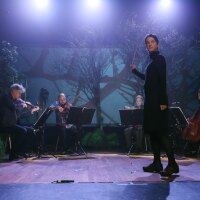Sound Engineer Discusses Intricacies of Turning a Made-for-TV Opera Into an Auditory Experience

Vireo, the groundbreaking made-for-TV opera, is now available for streaming. Watch the 12 full episodes and dive into the world of Vireo through librettos, essays and production notes. Find more bonus content on KCET.org and LinkTV.org.
In an opera, the spectacle and glamour of the singers and sets are integral parts of the experience. So how do you transform an opera, with all its costumes and choreography, into a purely auditory experience? This was the challenge composer Lisa Bielawa and recording engineer Eric Liljestrand had before them, when they turned the 2017 mutli-part made-for-television opera “Vireo: The Spiritual Biography of a Witch's Accuser” into an audio-only recording. That album was released in January by Orange Mountain Music for purchase at Amazon and iTunes as a two-disc set or digital album.
Like the audio in the original televised version, the sound for the album was recorded live during filming. All shooting took place on location — including a memorable day on Alcatraz Prison —with only a few takes for any given scene due to time frame and budget. Recording “Vireo” involved up to 32 microphones per episode, mostly on singers and musicians but also placed around the sets. Liljestrand also mixed and edited all of the episodes for the TV version. He’s a nearly 36-year veteran of the music industry, having produced and engineered numerous studio albums, films and network shows.
“There were a lot of problems,” Liljestrand said. “Alcatraz was probably the craziest location. I left there not knowing if I had it frankly. We had to run on generator power, and my system went black at one point during the day. Computers do not like that… but everything turned out well in the end.”
The biggest difference between the episodic version of “Vireo” and the auditory version is the removal of sounds that were specifically meant for the picture. This includes sound effects like the “thumps” for when an actor would fall, footsteps, clothing movement and the like — these wouldn’t make any sense without the visuals.
Removing the visuals also allowed the creative team more flexibility in choosing which takes to use for the CD. “Picture is king unfortunately, and we had to make compromises to match up with the picture,” Liljestrand said. “Things like vocals, mouths, you want the lips to be good. When you see instruments, you want the fingers to be good. It’s very, very distracting when they’re not.
“Frankly, picture editors don’t always respect the music,” he continued. “What’s close for them is not close for us. I like to tell people, ‘Yeah the picture editor works in frames; that’s a 24th or a 30th of a second. We’re working in samples, up to 48,000 per second. We can see something that is a quarter of a frame off and that’s horrible, really bothersome.”
At times, Liljestrand and Bielawa went with takes for the TV version that weren’t necessarily the best musical performances for the sake of the picture. For the CD, they were able to go back and insert their top choice.

Liljestrand also used the CD version as a chance to improve upon his original edits, tweaking balances and adjusting levels and prioritizing richness of tone, intonation and timing. In some places, he said he leaned into “a little crazier” effects to emphasize the surreal elements of the narrative, leaning into echoes and reverbs and layering the musician tracks on top of each other in a doubling fashion and then shifting them just out of sync with one another.
As with editing the television episodes, Liljestrand worked closely with the composer throughout this process. “Lisa [Bielawa] and I spent so much time sitting next to each other doing this we developed really good internal methodology,” he said. “She’s really on it. She has an amazing ear and an amazing memory. We could be listening and she’d say, ‘Oh this singer or instrument is flat in bar 43, but I know it’s good in take seven.’ She could just remember all this stuff and it was so… right.”
Adapting the audio for the CD took about a full week of work, accomplished in snatches and fragments when the pair had time to work on it alone or together. Liljestrand said he started hearing things he’d missed in the TV, like a violin melody in one episode returning as a vocal line in the next, and that he could likely sing the entire opera after having enjoyed such a deep dive into the material.
“This was hard. Like, really hard,” Liljestrand said. “And fun, too, I really enjoy the music, and I enjoy things that entail some risk. Bringing my computer and recording equipment into an abandoned train station with a leaky roof and just hoping it’s all going to work because this is the only day you can get it. We didn’t have enough time to set up, and the first time I hear everything was when we rolled. It was a rush.”
Bielawa is continuing to work on Vireo and is in the process of developing a hybrid film and opera experience at The New School in New York City, to be workshopped next year.
Top Image: Laurie Rubin in "Vireo" | Remsen Allard


